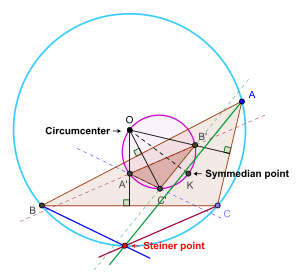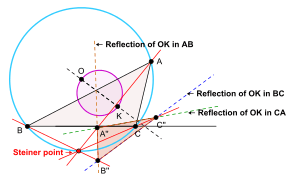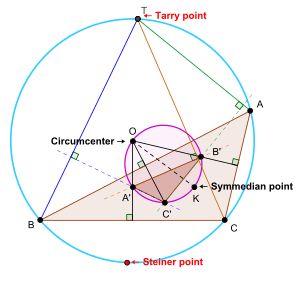Steiner point (triangle)
In triangle geometry, the Steiner point is a particular point associated with a plane triangle.[1] It is a triangle center[2] and it is designated as the center X(99) in Clark Kimberling's Encyclopedia of Triangle Centers. Jakob Steiner (1796–1863), Swiss mathematician, described this point in 1826. The point was given Steiner's name by Joseph Neuberg in 1886.[2][3]
Definition

The Steiner point is defined as follows. (This is not the way in which Steiner defined it.[2])
- Let ABC be any given triangle. Let O be the circumcenter and K be the symmedian point of triangle ABC. The circle with OK as diameter is the Brocard circle of triangle ABC. The line through O perpendicular to the line BC intersects the Brocard circle at another point A' . The line through O perpendicular to the line CA intersects the Brocard circle at another point B' . The line through O perpendicular to the line AB intersects the Brocard circle at another point C' . (The triangle A'B'C' is the Brocard triangle of triangle ABC.) Let LA be the line through A parallel to the line B'C' , LB be the line through B parallel to the line C'A' and LC be the line through C parallel to the line A'B' . Then the three lines LA, LB and LC are concurrent. The point of concurrency is the Steiner point of triangle ABC.
In the Encyclopedia of Triangle Centers the Steiner point is defined as follows;

- Let ABC be any given triangle. Let O be the circumcenter and K be the symmedian point of triangle ABC. Let lA be the reflection of the line OK in the line BC, lB be the reflection of the line OK in the line CA and lC be the reflection of the line OK in the line AB. Let the lines lB and lC intersect at A″, the lines lC and lA intersect at B″ and the lines lA and lB intersect at C″. Then the lines AA″, BB″ and CC″ are concurrent. The point of concurrency is the Steiner point of triangle ABC.
Trilinear coordinates
The trilinear coordinates of the Steiner point are given below.
- ( bc / ( b2 − c2) : ca / (c2 − a2) : ab / (a2 − b2 ) )
- = ( b2c2 csc(B − C) : c2a2 csc(C − A) : a2b2 csc(A − B) )
Properties
- The Steiner circumellipse of triangle ABC, also called the Steiner ellipse, is the ellipse of least area that passes through the vertices A, B and C. The Steiner point of triangle ABC lies on the Steiner circumellipse of triangle ABC.
- Honsberger stated the following as a property of Steiner point: The Steiner point of a triangle is the center of mass of the system obtained by suspending at each vertex a mass equal to the magnitude of the exterior angle at that vertex.[4] The Steiner point does not have this property. The center of mass of a system obtained by suspending at each vertex of a triangle ABC a mass equal to the magnitude of the exterior angle at that vertex is not the Steiner point. This center of mass is called the Steiner curvature centroid of triangle ABC and it has the trilinear coordinates ( ( π − A ) / a, ( π − B ) / b, ( π − C ) / c ).[5] It is the triangle center designated as X(1115) in Encyclopedia of Triangle Centers.
- The Simson line of the Steiner point of a triangle ABC is parallel to the line OK where O is the circumcenter and K is the symmmedian point of triangle ABC.
Tarry point

The Tarry point of a triangle is closely related to the Steiner point of the triangle. Let ABC be any given triangle. The point on the circumcircle of triangle ABC diametrically opposite to the Steiner point of triangle ABC is called the Tarry point of triangle ABC. The Tarry point is a triangle center and it is designated as the center X(98) in Encyclopedia of Triangle Centers. The trilinear coordinates of the Tarry point are given below:
- ( sec ( A + ω ) : sec (B + ω ) : sec ( C + ω ) ),
- where ω is the Brocard angle of triangle ABC.
- = ( f( a, b, c ) : f( b, c, a ) : f( c, a, b ) ),
- where f( a, b, c ) = bc / ( b4 + c4 − a2b2 − a2c2 )
Similar to the definition of the Steiner point, the Tarry point can be defined as follows:
- Let ABC be any given triangle. Let A'B'C' be the Brocard triangle of triangle ABC. Let LA be the line through A perpendicular to the line B'C' , LB be the line through B perpendicular to the line C'A' and LC be the line through C perpendicular to the line A'B' . Then the three lines LA, LB and LC are concurrent. The point of concurrency is the Tarry point of triangle ABC.
References
- ↑ Paul E. Black. "Steiner point". Dictionary of Algorithms and Data Structures. U.S. National Institute of Standards and Technology. Retrieved 17 May 2012.
- 1 2 3 Kimberling, Clark. "Steiner point". Retrieved 17 May 2012.
- ↑ J. Neuberg (1886). "Sur le point de Steiner". Journal de mathématiques spéciales: 29.
- ↑ Honsberger, Ross (1965). Episodes in nineteenth and twentieth century Euclidean geometry. The Mathematical Association of America. pp. 119–124.
- ↑ Eric W., Weisstein. "Steiner Curvature Centroid". MathWorld—A Wolfram Web Resource. Retrieved 17 May 2012.